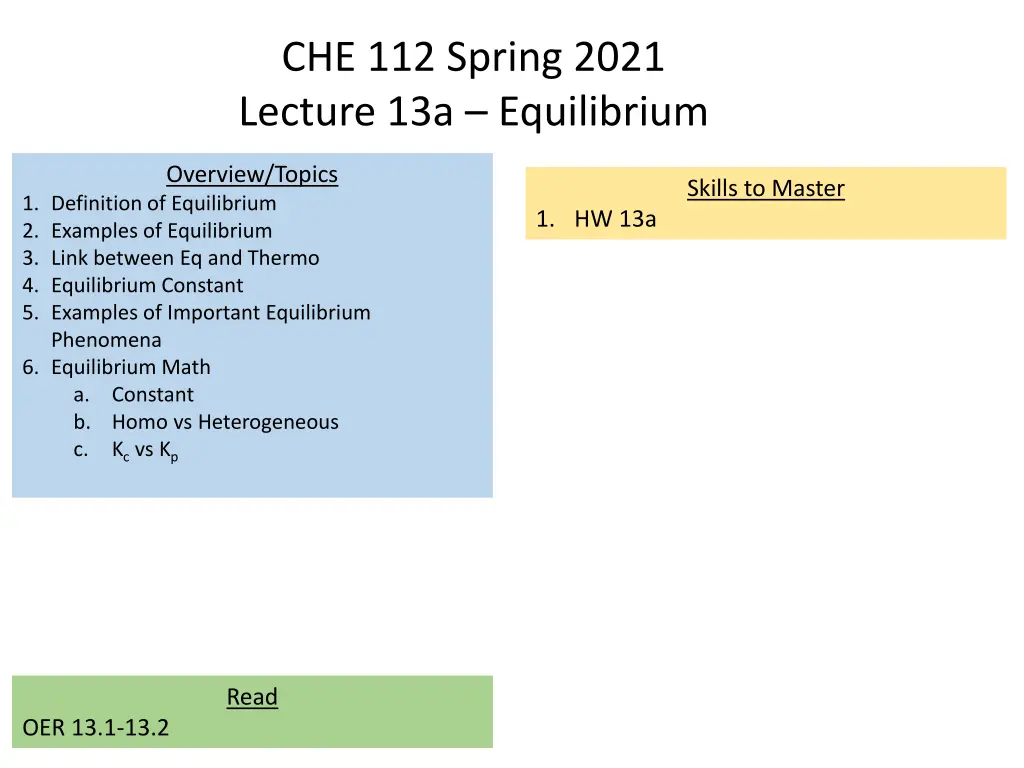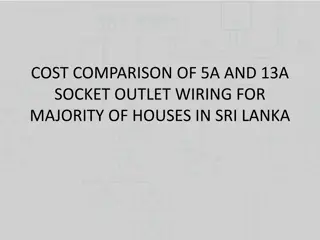
Mastering Equilibrium Concepts and Examples: CHE 112 Spring 2021 Lecture 13a
Explore the fundamentals of equilibrium, including its definition, examples, connection with thermodynamics, equilibrium constants, key phenomena, and mathematical aspects. Dive into past examples like phase changes, dynamic equilibrium, solubility, and thermodynamics equilibrium to enhance your understanding. Gain insights into equilibrium constants such as Kc and Qc, different equilibrium scenarios, and the mathematics behind equilibrium calculations.
Download Presentation

Please find below an Image/Link to download the presentation.
The content on the website is provided AS IS for your information and personal use only. It may not be sold, licensed, or shared on other websites without obtaining consent from the author. If you encounter any issues during the download, it is possible that the publisher has removed the file from their server.
You are allowed to download the files provided on this website for personal or commercial use, subject to the condition that they are used lawfully. All files are the property of their respective owners.
The content on the website is provided AS IS for your information and personal use only. It may not be sold, licensed, or shared on other websites without obtaining consent from the author.
E N D
Presentation Transcript
CHE 112 Spring 2021 Lecture 13a Equilibrium Overview/Topics Skills to Master 1. Definition of Equilibrium 2. Examples of Equilibrium 3. Link between Eq and Thermo 4. Equilibrium Constant 5. Examples of Important Equilibrium Phenomena 6. Equilibrium Math a. Constant b. Homo vs Heterogeneous c. Kc vs Kp 1. HW 13a Read OER 13.1-13.2
Past Examples Phase Changes (Ch. 10) Solid Liquid Vapor (gas) Liquid
Dynamic Equilibrium Dynamic Equilibrium Dynamic Equilibrium constantly evaporating and condensing rate is equal Rate of Evaporation = Rate Condensation Amount of Liquid Amount of Vapor Evaporation: liquid gas Condensation gas liquid We see this again in Ch. 13-15
Thermodynamics Equilibrium 1. What happens when you open the connection between boxes? 2. What happens if you add more in the Right? 3. What happens if you add more in the Left? Kc = 50
Rate Forward Rxn = Rate of Reverse Rxn Amount of R Amount of P Equilibrium and Chemical Reactions A + B C A + B C vs C C A + B A + B
Mathematics of Equilibrium a A + b B c C + d D Kc = Equilibrium Constant Temperature Dependent Unit less Include State = (aq) or (g) ignore s, and l Kc = [ Products ] [ Reactants ] [ C ]c [ D ]d [ A ]a [ B ]b = Large K favors the Products (K > 103) Small K favors the Reactants (K < 10-3) Medium K both R and P exist in appreciable amounts (10-3 < K < 103) Kc = Equilibrium Constant Qc = Reaction Quotient
Qc = Reaction Quotient Kc = Equilibrium Constant o Equilibrium Constant (1 value) o Given (or calculated) o Occurs at Equilibrium o Reaction Quotient (any value) o Calculated o Current state of the reaction Kwhatever Kp = Gas Equilibrium Constant o Same as Kc except uses Pressure o Only use if all R and P are gasses Lots of others K s Keq K1, K2 Kc , Kc Kc Etc R = 0.0821L atm mol K Kp = Kc (RT) n T = Temp (K) n = change in mols gas P-R
Reverse of a Reaction is the Inverse of the Kc [ C ]c Kc = A + B C [ A ]a [ B ]b 1 Kc = Kc [ A ]a [ B ]b Kc = C A + B [ C ]c Sum of the Reactions is the Product of the Kc s K1 = 0.42 2 NOBr (g) 2 NO (g) + Br2 (g) Br2 (g) + Cl2 (g) 2 BrCl(g) K2 = 7.2 K1 K2 = 3.0 2 NO (g) + 2 BrCl(g) 2 NOBr (g) + Cl2 (g)
Multiplication of a Reaction is the Square of the Kc [ NO2 ]2 [ N2O4 ] Kc = N2O4 (g) 2 NO2 (g) = 4.63x10-3 [ NO2 ] [ N2O4 ]1/2 N2O4 (g) 1 NO2 (g) Kc = = 0.0680 Kc = (Kc )2 or (Kc)1/2 = Kc
Writing Equilibrium Equations (aq) o Standard State for (aq) = 1 M o Ignore pure Solids and Liquids Examples 4 PCl3 (l ) P4 (s) + 6 Cl2 (g) H3O+ (aq) + F- (aq) HF (aq) + H2O (l)
Kp Gas Phase Equilibriums o Same as Kc except uses Pressure o Only use if all R and P are gasses Kp = [ Products ] [ Reactants ] ( PC )c ( PD )d ( PA )a ( PB )b = Ugly Derivation/Math Review: PV = nRT ? ? Relationship between Kp and Kc P = RT R = 0.0821L atm mol K Kp = Kc (RT) n T = Temp (K) n = change in mols gas P-R
Examples 2 NO (g) + O2 (g) 2 NO2 (g) (a) Write Kc (b) Write Kp (c) Given that Kc = 2.4x103 at 400.K, Calculate Kp (d) Does the reaction favor: P/R/Both?
Summary 1. [ ] = concentration (mol/L) or atm 2. Kp =Kc(RT) n 3. Ignore pure solids and liquids 4. Kc value are Temperature Dependent 5. Kc values are reaction/equation specific 6. Sum of reactions = product of Kc 7. Kf = 1/Kf (reverse reaction, inverse Kc) 8. K > 1 Favors Products 9. K< 1 Favors Reactants 10. Reactants 10-3 < K (both)< 103 Products






















